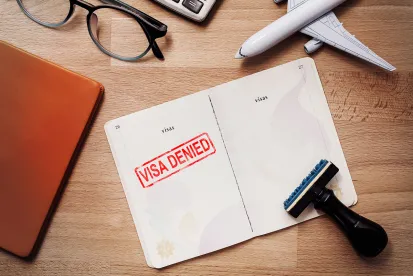On August 12, 2020, the Department of State (DOS) issued updated guidance regarding the “National Interest” exemption to the Presidential Proclamation that bans entry to the U.S. for H-1B, H-2B, L-1 and certain J-1 travelers who were outside the United States and not in possession of a valid visa or travel document as of the effective date of June 24, 2020.
For our earlier guidance on the travel ban, please see our original alert and our June 30 update.
Contradictory Guidance on Who Is Subject to the Travel Ban
The August 12 updated guidance creates some confusion, as it contradicts the most recent Presidential announcement on the travel ban.
The DOS update states that the proclamation does not apply to visa applicants who:
-
were in the United States on June 24, the effective date of the Proclamation; or
-
had a valid H-1B, H-2B, L-1 or J-1 visa on June 24, and will return to the United States on that visa; or
-
had another valid travel document as of June 24.
However, on June 29, 2020, President Trump issued an Amendment to the June 22 Presidential Proclamation which resolved the issue of what it means to have a “Valid Nonimmigrant Visa” that would exempt an individual from the travel ban if he or she was outside the United States on June 24. In effect, a person who was outside the U.S. on June 24, 2020 is exempt from the travel ban only if he or she:
- Holds a valid, unexpired visa in one of the classifications listed in the travel ban (H-1B, H-2B, J-1, L-1), and
- Is reentering the United States with the same visa that was valid on June 24, 2020.
Until further guidance is issued to clarify this discrepancy, we recommend that foreign nationals take a cautious approach and follow the guidance in the June 29 amendment to the Presidential Proclamation.
Detailed Guidance on “National Interest” Waiver of the Travel Ban for Visa Applicants
The original Presidential Proclamation provided an exemption to the travel ban for an individual whose entry would be in the national interest.
The Department of State guidance provides specific and more expansive detail on when the national interest exemption may allow a foreign national to apply for a visa if they are subject to the Travel Ban. A number of individuals who are subject to the travel ban may be eligible to apply for a visa and enter the United States on this basis. If an individual meets the national interest standard and is eligible to apply for a visa, his or her dependent spouse and children may also apply for a visa and enter the United States.
Below are the categories of national interest exemptions for H-1B, H-2B, and L-1 visas:
| H-1B VISA | H-2B VISA | L-1A VISA | L-1B VISA |
|---|---|---|---|
|
Travel as a public health or healthcare professional, or researcher, to alleviate the effects of the COVID-19 pandemic, or to conduct ongoing medical research in an area with a substantial public health benefit.
|
|
Travel as a public health or healthcare professional, or researcher, to alleviate the effects of the COVID-19 pandemic, or to conduct ongoing medical research in an area with a substantial public health benefit.
|
Travel as a public health or healthcare professional, or researcher, to alleviate the effects of the COVID-19 pandemic, or to conduct ongoing medical research in an area with a substantial public health benefit.
|
|
Travel supported by a request from a U.S. government agency or entity to meet critical U.S. foreign policy objectives or to satisfy treaty or contractual obligations. |
Travel supported by a request from a U.S. government agency or entity to meet critical U.S. foreign policy objectives or to satisfy treaty or contractual obligations. |
Travel supported by a request from a U.S. government agency or entity to meet critical U.S. foreign policy objectives or to satisfy treaty or contractual obligations. |
Travel supported by a request from a U.S. government agency or entity to meet critical U.S. foreign policy objectives or to satisfy treaty or contractual obligations. |
|
Travel by applicants seeking to resume ongoing employment in the United States in the same position with the same employer and visa classification. This is limited to cases where Part II, Question 2 of the approved Form I-129 indicates that the applicant is continuing in “previously approved employment without change with the same employer.” |
|
Travel by applicants seeking to resume ongoing employment in the United States in the same position with the same employer and visa classification |
Travel by applicants seeking to resume ongoing employment in the United States in the same position with the same employer and visa classification |
|
Travel by technical specialists, senior level managers, and other workers whose travel is necessary to facilitate the immediate and continued economic recovery of the United States. This may be applicable when at least two of five indicators provided by the Department of State are met, as described below. |
Travel necessary to facilitate the immediate and continued economic recovery of the United States. This may be applicable when at least two of three indicatorsprovided by the Department of State are met, as described below. |
Travel by a senior level executive or manager filling a critical business need of an employer, and/or meeting a critical infrastructure need. This may be applicable when at least two of three indicators provided by the Department of State are met, as described below. New Office L-1s likely do not qualify for an exception unless the new office will employ five or more U.S. workers.
|
Travel as a technical expert or specialist meeting a critical infrastructure need. This may be applicable when all threeindicators provided by the Department of State are met, as described below. |
H-1B visa: The five indicators for “economic recovery” are:
-
The employer has a continued need for the services or labor to be performed by the H-1B nonimmigrant in the U.S. Labor Condition Applications (LCAs) approved by DOL during or after July 2020 will be treated more favorably. For LCAs approved by DOL before July 2020, the burden is on the employer to demonstrate the continuing need of the applicant’s employment with the employer. In any case, if an applicant is currently performing or is able to perform the role remotely from outside the United States, then this indicator is not satisfied.
-
The applicant’s position demonstrates that he or she will provide “significant and unique contributions” to the employer meeting a critical infrastructure need. Critical infrastructure sectors are chemical, communications, dams, defense industrial base, emergency services, energy, financial services, food and agriculture, government facilities, healthcare and public health, information technology, nuclear reactors, transportation, and water systems. For this indicator to be satisfied, employment in a critical infrastructure must be in one of two types of positions noted below
-
Senior level placement within the employer’s organization or job duties that are both “unique and vital to the management and success of the overall business”
-
The job duties and qualifications indicate the individual will provide “significant and unique contributions” to the employer.
-
-
The wage rate paid to the H-1B applicant meaningfully exceeds the prevailing wage rate by at least 15 percent, as evidenced by the LCA that supports the H-1B petition.
-
The H-1B applicant’s education, training and/or experience demonstrate unusual expertise in the specialty occupation in which the applicant will be employed. For example, an H-1B applicant with a doctorate or professional degree, or many years of relevant work experience, may have such advanced expertise in the relevant occupation as to make it more likely that he or she will perform critically important work for the employer.
-
Denial of the visa will cause financial hardship to the U.S. employer. Examples include the employer’s inability to meet financial or contractual obligations; the employer’s inability to continue its business; or a delay or other impediment to the employer’s ability to return to its pre-COVID-19 level of operations.
H-2B visa: The three indicators for “economic recovery” are:
-
The applicant was previously employed and trained by the petitioning U.S. employer, as evidenced by having two or more prior H-2B approvals for the same employer.
-
The applicant is traveling based on a temporary labor certification (TLC) that reflects continued need for the worker. TLCs approved by DOL during or after July 2020 will be treated more favorably. For TLCs approved by DOL before July 2020, the burden is on the employer to demonstrate the continuing need of the applicant’s employment.
-
Denial of the visa will cause financial hardship to the U.S. employer. Examples include: the employer’s inability to meet financial or contractual obligations; the employer’s inability to continue its business; or a delay or other impediment to the employer’s ability to return to its pre-COVID-19 level of operations.
L-1A visa: The three indicators for “critical business need” are:
-
Will be a senior-level executive or manager;
-
Has spent multiple years with the company overseas; or
-
Will fill a critical business need for a company meeting a critical infrastructure need. Critical infrastructure sectors include chemical, communications, dams, defense industrial base, emergency services, energy, financial services, food and agriculture, government facilities, healthcare and public health, information technology, nuclear reactors, transportation, and water systems.
L-1B visa: The three indicators for “critical infrastructure need” are:
-
The applicant will provide “significant and unique contributions” to the employer;
-
The applicant’s specialized knowledge is specifically related to a critical infrastructure need. The list of “critical infrastructure” is not defined for L-1B visa applicants, but presumably is the same as those listed above for L-1A and H-1B visa applicants; and
-
The applicant has spent multiple years with the company overseas.
Process for Requesting a Visa Appointment Based on National Interest
It is important to keep in mind that the Department of State has authorized U.S. Consular Posts to make visa services available at their own discretion. As of July 15, many Consular Posts began resuming routine visa services on a limited basis. Each Embassy or Consulate will publish procedures for visa applications on its website.




 />i
/>i

